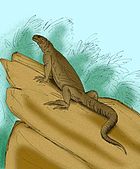| Dalinghosaurus Temporal range:
Early Cretaceous,
~ | |
|---|---|

| |
| Dalinghosaurus longidigitus on display at the Paleozoological Museum of China | |
|
Scientific classification
| |
| Domain: | Eukaryota |
| Kingdom: | Animalia |
| Phylum: | Chordata |
| Class: | Reptilia |
| Order: | Squamata |
| Suborder: | Anguimorpha |
| Infraorder: | Paleoanguimorpha |
| Clade: | Shinisauria |
| Genus: | † Dalinghosaurus |
| Species: | †D. longidigitus
|
| Binomial name | |
| †Dalinghosaurus longidigitus Ji, 1998
| |
Dalinghosaurus (often incorrectly spelled "Dalinghesaurus") is an extinct genus of lizards, first described in 1998 by S.A. Ji of the Peking University Department of Geology. The type species is Dalinghosaurus longidigitus. [1] It is known from the Early Cretaceous ( Aptian) aged Yixian Formation of Liaoning, China.
Description

Dalinghosaurus had extremely long tails and hindlimbs relative to its forelimbs. The claws are relatively slender. [2]
Eleven specimens of Dalinghosaurus are held by the IVPP in Beijing. One fossil skeleton contains the skeletons of ten or more juveniles. [3] A possible specimen of Dalinghosaurus has been found in the gut region of a Sinosauropteryx. [2]
Classification
Although it lived during the Early Cretaceous, A 2005 study found that Dalinghosaurus was related to several modern-day lizards in the family Xenosauridae, the knob-scaled lizards. Its relatives include the modern Chinese crocodile lizard (Shinisaurus) of southern China, the extinct Exostinus of Montana and Wyoming, and the extinct Carusia of Mongolia. It is differentiated from Carusia by having fewer, more conical shaped teeth. Differences in skull and mandible shape separate it from Shinisaurus. [3]
Paleobiology
The long legs of Dalinghosaurus indicate that it was a proficient runner across open environments, potentially capable of bipedal locomotion. However, it may also have been capable of arboreal locomotion. [2]
References
- ^ Ji, S.A. (1998). "A new long−tailed lizard from the Upper Jurassic of Liaoning, China". In: Department of Geology, Peking University (ed.), Collected Works of International Symposium on Geological Science, Peking University, Beijing, China, pp 496–505. Seismological Press, Beijing.
- ^ a b c Smithwick, F.M.; Nicholls, R.; Cuthill, I.C.; Vinther, J. (2017). "Countershading and Stripes in the Theropod Dinosaur Sinosauropteryx Reveal Heterogeneous Habitats in the Early Cretaceous Jehol Biota". Current Biology. 27 (21): 3337–3343.e2. doi: 10.1016/j.cub.2017.09.032. hdl: 1983/8ee95b15-5793-42ad-8e57-da6524635349. PMID 29107548.
- ^ a b Evans, S.E. and Wang, Y. (2005). " The Early Cretaceous lizard Dalinghosaurus from China". Acta Palaeontologica Polonica 50 (4): 725–742.
